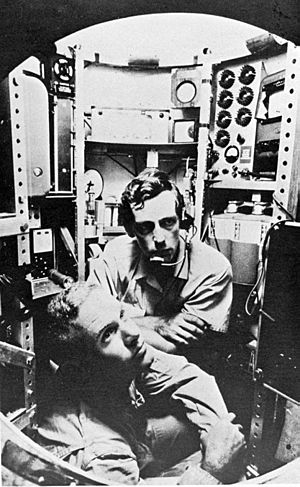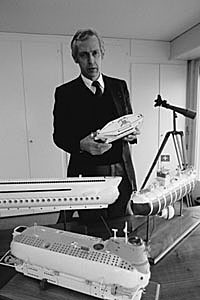Jacques Piccard facts for kids
Quick facts for kids
Jacques Piccard
|
|
|---|---|

Piccard in 1979
|
|
| Born | 28 July 1922 Brussels, Belgium
|
| Died | 1 November 2008 (aged 86) Cully, Switzerland
|
| Nationality | Swiss |
| Children | Bertrand Piccard (son) |
| Parent(s) |
|
| Relatives | Jean Felix Piccard (uncle) |
| Known for | Bathyscaphe |
| Awards | Hubbard Medal (2012) |
Jacques Piccard (born July 28, 1922 – died November 1, 2008) was a Swiss oceanographer and engineer. He was famous for creating special underwater vehicles called submersibles. These vehicles helped explore the deep parts of the ocean.
Jacques Piccard and Lt. Don Walsh made history together. They were the first people to explore the very deepest known part of Earth's ocean. This incredible place is called the Mariana Trench, located in the western Pacific Ocean.
Contents
A Family of Explorers
Jacques Piccard was born in Brussels, Belgium. His father, Auguste Piccard, was also a famous adventurer and engineer. Auguste Piccard set world records for flying high in a balloon in the 1930s.
The Piccard family is special because they hold unique world records. They achieved both the highest flight in a balloon and the deepest dive into the ocean!
Here's a look at some of the famous Piccard family members:
- Jules Piccard (a chemistry professor)
- Auguste Piccard (Jacques's father, a physicist and explorer)
- Jacques Piccard (the ocean explorer we are learning about)
- Bertrand Piccard (Jacques's son, also a famous explorer)
- Jacques Piccard (the ocean explorer we are learning about)
- Jean Felix Piccard (Auguste's brother, also an explorer)
- Jeannette Piccard (Jean Felix's wife, also an explorer)
- Don Piccard (Jean Felix and Jeannette's son)
- Auguste Piccard (Jacques's father, a physicist and explorer)
Jacques's father, Auguste, used his knowledge of balloons to create a new type of underwater vehicle. This vehicle was called a bathyscaphe. It worked by using buoyancy, similar to how a balloon floats.
Jacques first taught economics at the University of Geneva. But he also helped his father improve the bathyscaphe. They wanted to show that it could explore very deep waters. Jacques also earned a diploma from the Graduate Institute of International Studies in Geneva.
Between 1948 and 1955, Jacques and his father built three bathyscaphes. These amazing machines reached record depths of 4,600 feet and 10,000 feet! The last one they built was bought by the government.
Because of this success, Jacques left his economics career. He decided to work full-time with his father. They wanted to make the bathyscaphe even better for ocean exploration and research.
Jacques's son, Bertrand Piccard, continues the family's tradition of adventure. In 1999, he commanded the first non-stop balloon flight around the world. Then, in 2009, he led the first solar-powered plane flight around the world!
Journey to the Deepest Ocean
Jacques Piccard looked for money to help with his deep-sea projects. The United States Navy was interested in designing submarines for underwater research. They invited Jacques to the U.S. to show them his bathyscaphe, which was now named the Trieste.
The U.S. Navy was very impressed with his designs. They bought the Trieste and hired Piccard as a consultant. The Navy saw how useful a working submersible could be for finding lost submarines or rescuing people. So, they began testing the Trieste to reach even greater depths.
The Trieste could already reach depths of 24,000 feet. But Piccard and his team planned an even bigger challenge. They wanted to go to the very bottom of the ocean.
On January 23, 1960, Piccard and Lt. Don Walsh made history. They reached the floor of the Mariana Trench. This trench is located in the western North Pacific Ocean.
The depth they reached was measured at 10,916 meters (about 35,813 feet). Later, more accurate measurements showed it was slightly less deep, at 10,911 meters (about 35,797 feet). The trip down took almost five hours!
The bathyscaphe did not carry much scientific equipment. The main goal of the mission was to prove that humans could reach such extreme depths. The descent went smoothly until they reached 30,000 feet. Then, the crew heard a loud crack. However, they decided to keep going down.
Finally, they landed in soft, "snuff-colored ooze" at 35,800 feet. When they reached the bottom, they saw a flat fish and a new type of shrimp. Some marine biologists later questioned if fish could survive the enormous pressure there. The pressure at that depth is about 17,000 pounds per square inch!
Piccard noticed cracks in the viewing windows. Because of this, he decided to cut the trip short. After only 20 minutes on the seabed, they started to drop ballast to rise back up. The damaged vessel returned to its escort ships safely in three hours and 15 minutes.
This historic dive gained worldwide attention. Piccard wrote a book about it called Seven Miles Down. He wrote it with Robert Deitz, a geologist who helped plan the mission. A planned return trip never happened. The Trieste was expensive to keep and operate. It also couldn't collect samples or take photos, so it didn't gather much scientific data. The original Trieste was retired in 1961. However, a rebuilt version later found the remains of two lost U.S. Navy nuclear submarines. These were the Thresher and the Scorpion.
The Ben Franklin Mission
On July 14, 1969, just two days before the Apollo 11 moon launch, another mission began. The Ben Franklin submersible was towed to the middle of the Gulf Stream. This was off the coast of Palm Beach, Florida.
Once there, the Ben Franklin and its six-person international crew went down to 1,000 feet. They then drifted 1,444 miles north with the current for over four weeks. They finally surfaced near Maine.
The crew included Jacques Piccard as the mission leader. Erwin Aebersold, another Swiss, was Piccard's chosen pilot and main assistant. He also worked as a project engineer during the Franklin's design.
Grumman chose Don Kazimir, a Navy submariner, to be the captain. The U.S. Navy Oceanographic Office sent Frank Busby. He surveyed the ocean floor along their drift path. The Royal Navy sent Ken Haigh, an expert in underwater sound. He studied how sound traveled in the water during the mission.
The sixth crew member was Chet May from NASA. He specialized in how people work in space. Wernher von Braun, a famous rocket scientist, learned about the Franklin mission. He visited the submarine and saw it as a test for long space missions, like the future Skylab. He sent May as a NASA observer to study how long periods of isolation affected the crew.
The 50-foot Ben Franklin was built between 1966 and 1968. It was named after Benjamin Franklin, an American inventor. He was one of the first people to map the Gulf Stream. The Ben Franklin was built in Switzerland for Piccard and the Grumman Aircraft Engineering Corporation. Today, it has been restored and is on display at the Vancouver Maritime Museum in Canada.
Awards and Recognition
Jacques Piccard received several honors for his work.
- In 1972, he was given the Howard N. Potts Medal.
- In 1981, Piccard became a founding member of the World Cultural Council. This organization promotes science, art, and education.
- On February 1, 2008, he received an honorary doctorate from the Catholic University of Louvain in Belgium.
See also
 In Spanish: Jacques Piccard para niños
In Spanish: Jacques Piccard para niños




